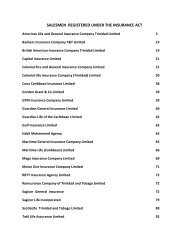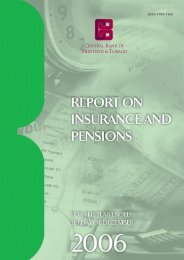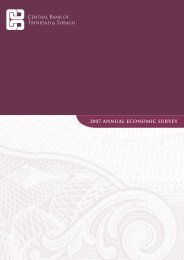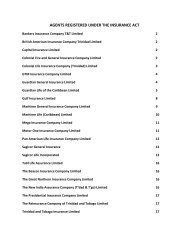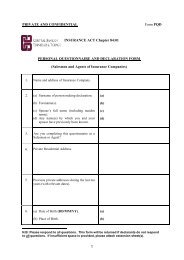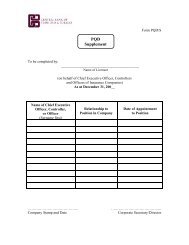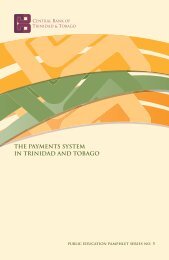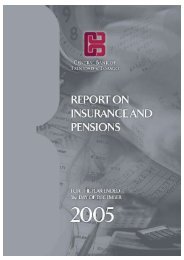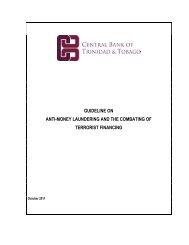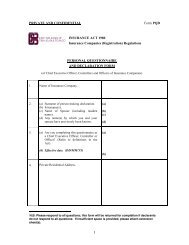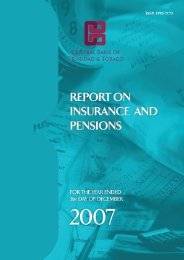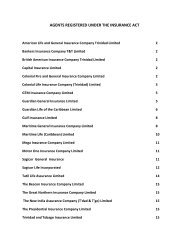Prudent Person Approach to Investment and Lending Guideline
Prudent Person Approach to Investment and Lending Guideline
Prudent Person Approach to Investment and Lending Guideline
You also want an ePaper? Increase the reach of your titles
YUMPU automatically turns print PDFs into web optimized ePapers that Google loves.
FINALMay 2005<strong>Prudent</strong> <strong>Person</strong> <strong>Approach</strong><strong>to</strong><strong>Investment</strong> <strong>and</strong> <strong>Lending</strong> <strong>Guideline</strong>
Table of Contents1. Introduction 12. Purpose of the <strong>Guideline</strong> 13. The Framework 24. The Policy 25. Operational Procedures 36. Responsibility of the Board of Direc<strong>to</strong>rs 47. Responsibility of Senior Management 58. Risk Management, Internal Controls <strong>and</strong> Reporting 5• Risk Management 5• Internal Controls 6• Reporting 79. Supervisory Oversight 8
PRUDENT PERSON APPROACH TO INVESTMENT AND LENDING GUIDELINE1. INTRODUCTION1.1 Financial institutions 1 have a statu<strong>to</strong>ry as well as a fiduciary responsibility <strong>to</strong> prudently manage thefunds entrusted <strong>to</strong> them by deposi<strong>to</strong>rs, inves<strong>to</strong>rs <strong>and</strong> policyholders. Therefore, the Board of Direc<strong>to</strong>rs 2<strong>and</strong> management of these institutions, in carrying out their obligations, should exercise the care,diligence <strong>and</strong> skill that a reasonably prudent person would exercise in similar circumstances. 31.2 Prudence must be evident principally in the process by which investment <strong>and</strong> lending strategies aredeveloped, implemented <strong>and</strong> moni<strong>to</strong>red <strong>and</strong> must therefore be a main consideration in the institution’srisk management system. This system should include a reasonable process for arriving at investment<strong>and</strong> lending decisions. Retrospective assessment of whether investment or lending decisions weresuccessful is not sufficient.1.3 The Financial Institutions Act, 1993 (FIA) <strong>and</strong> the Insurance Act Chap. 84:01 (IA) set out limits <strong>and</strong>restrictions relating <strong>to</strong> lending <strong>and</strong> investment with which financial institutions must comply. The CentralBank considers that these limits are <strong>to</strong> be regarded as a minimum st<strong>and</strong>ard <strong>and</strong> that the internal policiesof financial institutions should be more stringent, depending on the institution’s risk profile <strong>and</strong> risk<strong>to</strong>lerance levels so as <strong>to</strong> maintain a sound financial operation.2. PURPOSE OF THE GUIDELINE2.1 The purpose of this <strong>Guideline</strong> is <strong>to</strong> provide the Board of Direc<strong>to</strong>rs <strong>and</strong> management of financialinstitutions with a framework for the establishment of policies <strong>and</strong> procedures for the prudentmanagement <strong>and</strong> control of risk in their investment <strong>and</strong> lending portfolios. The framework willencompass statu<strong>to</strong>ry requirements <strong>and</strong> will also be used by the Central Bank of Trinidad <strong>and</strong> Tobago(‘the Central Bank’) in its evaluation of a financial institution’s investment <strong>and</strong> lending activities <strong>to</strong>determine whether it is in a sound financial condition.1 For purposes of this guideline, financial institutions refer <strong>to</strong> institutions licensed under the Financial Institutions Act, 1993 (FIA) <strong>to</strong> carryon the business of banking <strong>and</strong> business of a financial nature as well as insurance companies <strong>and</strong> pension fund plans registered under theInsurance Act Chap. 84:01(IA).2 In this guideline, “Board of Direc<strong>to</strong>rs” or “Board” shall, in the case of a pension fund plan, mean its trustees <strong>and</strong> includes a trustcorporation in which a management committee shall be established.3 This represents a restatement of the prudent person rule which states that ‘a fiduciary must discharge his or her duties with the care, skill,prudence <strong>and</strong> diligence that a prudent person acting in a like capacity would use in the conduct of an enterprise of like character <strong>and</strong> aims’.
<strong>Prudent</strong> <strong>Person</strong> <strong>Approach</strong> <strong>to</strong> <strong>Investment</strong> <strong>and</strong> <strong>Lending</strong> <strong>Guideline</strong>2.2 The <strong>Guideline</strong> refers <strong>to</strong> the investment <strong>and</strong> lending limits <strong>and</strong>/or restrictions set out in governinglegislation <strong>and</strong> takes in<strong>to</strong> consideration international best practice 4 . It is expected that certain aspects ofthe guideline (for example, the policies, procedures, risk management <strong>and</strong> internal controls) would beadapted <strong>to</strong> reflect the complexity <strong>and</strong> risks inherent in the institution’s investment <strong>and</strong> lending business.3. THE FRAMEWORK3.1 Every financial institution should implement sound investment <strong>and</strong> lending management policies <strong>and</strong>frameworks which should comprise the following steps:-3.1.1 Formulation <strong>and</strong> documentation of investment <strong>and</strong> lending policies, including a code of ethics<strong>and</strong> professional conduct;3.1.2 Approval <strong>and</strong> implementation of the policies;3.1.3 Risk management of investment <strong>and</strong> lending activities; <strong>and</strong>3.1.4 Reporting procedures <strong>to</strong> the appropriate level of authority.3.2 In developing investment <strong>and</strong> lending management frameworks, the Board <strong>and</strong> management offinancial institutions should ensure that the investment <strong>and</strong> lending strategies adopted by the financialinstitution, including its risk-return profile, are compatible with the liability structure of the institution interms of maturity <strong>and</strong> liquidity.4. THE POLICY4.1 Every financial institution should have written investment <strong>and</strong> lending policies which should satisfystatu<strong>to</strong>ry <strong>and</strong> regula<strong>to</strong>ry requirements, <strong>and</strong> should be communicated <strong>to</strong> all staff involved in investment<strong>and</strong> lending activities. The policies should: -4.1.1 Describe the objectives of the investment <strong>and</strong> lending program, which should be in accordancewith the overall risk philosophy of the institution as outlined in its strategic plan. The policiesshould take in<strong>to</strong> account the institution’s ability <strong>to</strong> absorb potential losses.4.1.2 Outline the expected composition of the portfolio by type, term (short or long), purpose (tradingor nontrading), <strong>and</strong> liquidity 5 . In addition, permissible investments <strong>and</strong> loans for the institution 64 This guideline encompasses the minimum criteria outlined in the IA <strong>and</strong> the Second Schedule <strong>to</strong> the FIA <strong>and</strong> builds on the frameworksoutlined by the International Association of Insurance Supervisors (IAIS), the Office of the Superintendent of Financial Institutions Canada(OSFI) <strong>and</strong> the Basel Committee on Banking Supervision.5Section 29 of the FIA requires that, in placement of liquid assets, banks <strong>and</strong> non-banks give preference <strong>to</strong> short term instrumentsoriginating in Trinidad <strong>and</strong> Tobago.6 Section 22(2) (b) of the FIA restricts institutions from acquiring l<strong>and</strong> except in circumstances as outlined in this section of the FIA.Permissible investments for insurance companies <strong>and</strong> pension funds are detailed in the Second Schedule of the IA.Central Bank of Trinidad <strong>and</strong> TobagoMay 2005 Page 2 of 8
<strong>Prudent</strong> <strong>Person</strong> <strong>Approach</strong> <strong>to</strong> <strong>Investment</strong> <strong>and</strong> <strong>Lending</strong> <strong>Guideline</strong>should be detailed, including any restrictions as <strong>to</strong> markets (e.g., only securities 7 listed onspecified s<strong>to</strong>ck exchanges), minimum rating requirements, etc.4.1.3 Specify statu<strong>to</strong>ry limits <strong>and</strong> restrictions <strong>and</strong> establish limits <strong>to</strong> prevent excessive concentrations<strong>and</strong> ensure sufficient diversification of the investment <strong>and</strong> lending portfolios. Limits 8 should beestablished for investments <strong>and</strong> loans, which may be based on ratings, markets, currency,industries <strong>and</strong> sec<strong>to</strong>rs. Limits 9 should also be established for investments <strong>and</strong> loans withcounterparties <strong>and</strong> related parties.4.1.4 Establish authorization procedures, limits <strong>and</strong> accountabilities for investment <strong>and</strong> lendingactivities . The framework of accountability for all investment <strong>and</strong> lending transactions shouldinclude details on who is authorised <strong>to</strong> undertake investment <strong>and</strong> lending transactions <strong>and</strong>procedures for approval of new investment instruments <strong>and</strong> loans. The approval process forloans <strong>and</strong> investments should also include the review <strong>and</strong> approval of legal documentationprior <strong>to</strong> the execution of the transaction.4.1.5 Outline the circumstances in which derivative instruments – or structured products that havethe economic effect of derivatives or any creative or innovative financial instrument – can beused. Limits should be established by type of instrument (e.g., swaps, options, <strong>and</strong> futures)<strong>and</strong> by counterparty.5. OPERATIONAL PROCEDURES5.1 Every financial institution is expected <strong>to</strong> have written internal procedures outlining how the investment<strong>and</strong> lending policies will be implemented <strong>and</strong> moni<strong>to</strong>red. The details of the procedures should beconsistent with the size <strong>and</strong> complexity of the financial institution’s investment <strong>and</strong> lending activities.The financial institution should:-5.1.1 Address exposures arising from both balance sheet <strong>and</strong> off-balance sheet items.5.1.2 Identify potential sources of conflict of interest <strong>and</strong> establish procedures <strong>to</strong> ensure that thoseinvolved in the investment <strong>and</strong> lending process underst<strong>and</strong> where these situations could arise<strong>and</strong> how they should be addressed.5.1.3 Establish procedures for the measurement <strong>and</strong> assessment of the performance of theinvestment <strong>and</strong> lending portfolios.7Section 22(2) (d) of the FIA sets out restrictions with respect <strong>to</strong> a licensee acquiring, dealing, underwriting or providing of finance forunderwriting or dealing in its own shares. There is a similar provision in section 48 of the IA. In addition, Section 22(2)(j) of the FIA setsout a limit on the acquisition <strong>and</strong> holding in the aggregate of any part of the share capital of any commercial, agricultural or industrialundertaking not including a financial institution.8 Section 47 of the IA sets out a local assets ratio with which insurance companies must comply <strong>and</strong> the Second Schedule prescribes limitsfor investment in specified assets. In addition, the proposed Agreed Minute on the Operation of the Foreign Currency Market (amendedAugust 14, 2000) requires commercial banks <strong>and</strong> other authorised dealers that accept foreign currency deposits <strong>to</strong> maintain a liquid assetsratio of 20% on foreign currency deposits.9 Refer <strong>to</strong> Section 22(2)(e)-(i) of the FIA. The Insurance (Admissible Assets <strong>and</strong> valuation of Assets) Regulations #14 prescribes limits forinvestment in related parties.Central Bank of Trinidad <strong>and</strong> TobagoMay 2005 Page 3 of 8
<strong>Prudent</strong> <strong>Person</strong> <strong>Approach</strong> <strong>to</strong> <strong>Investment</strong> <strong>and</strong> <strong>Lending</strong> <strong>Guideline</strong>5.1.4 Establish a comprehensive investment <strong>and</strong> lending risk management process 10 , includingprocedures <strong>to</strong> moni<strong>to</strong>r <strong>and</strong> control the institution’s exposure <strong>to</strong> fluctuations in interest rates,foreign exchange rates <strong>and</strong> market prices.5.1.5 Establish procedures for the administration of impaired loans <strong>and</strong> investments, includingmethodologies for estimating the recoverable amount of these assets.5.1.6 Establish the type <strong>and</strong> frequency of reports <strong>to</strong> be generated.5.1.7 Establish procedures for the selection <strong>and</strong> approval of new counterparties, brokers, externalvalua<strong>to</strong>rs <strong>and</strong> external asset managers. An independent process should be established <strong>to</strong>review all advice received from agents, brokers <strong>and</strong> external asset managers on theacquisition <strong>and</strong> disposal of investments <strong>and</strong> loans.5.1.8 Establish criteria <strong>and</strong> procedures for the cus<strong>to</strong>dy <strong>and</strong> safekeeping of investment <strong>and</strong> lendingdocuments, for example, those evidencing indebtedness <strong>and</strong> title. In addition, proceduresshould be established for obtaining independent confirmation of cus<strong>to</strong>dian statements whichshould be reconciled <strong>to</strong> the institution’s investment records on a regular basis.5.1.9 Detail the actions <strong>to</strong> be taken by the Board <strong>and</strong>/or senior management in cases of violations<strong>and</strong> non-compliance with established internal or regula<strong>to</strong>ry limits <strong>and</strong> procedures, whethercommitted deliberately or by inadvertence.5.2 Additionally, with respect <strong>to</strong> investments the institution should :-5.2.1 Address exposures arising from the trading <strong>and</strong> non-trading portfolios.5.2.2 Describe methodologies for valuing unlisted investments. Valuations should be conducted byindividuals independent of those responsible for trade execution or, if this is not possible,valuations should be independently checked or audited on a timely basis.5.2.3 Specify the accounting 11 <strong>and</strong> taxation treatment for investment instruments.5.2.4 Establish <strong>and</strong> maintain separate front <strong>and</strong> back office operations <strong>and</strong> procedures governingsame.6. RESPONSIBILITY OF THE BOARD OF DIRECTORS6.1 The Board of Direc<strong>to</strong>rs is responsible for the establishment <strong>and</strong> approval of the institution’s investment<strong>and</strong> lending policies developed by senior management. The Board of Direc<strong>to</strong>rs or a subcommittee ofthe Board (i.e., the <strong>Investment</strong> <strong>and</strong> Credit Committees) should, at least annually, review <strong>and</strong> approve10 Refer <strong>to</strong> Section 8 of this guideline.11 IAS 39 requires that purchases <strong>and</strong> sales of each broad category of financial assets be accounted for consistently using either trade date orsettlement date accounting. If settlement date accounting is used, IAS 39 requires recognition of certain value changes between trade <strong>and</strong>settlement dates. In addition, IAS 39 requires that trading <strong>and</strong> available for sale securities should be reported at current market prices, whileheld <strong>to</strong> maturity investments should be reported at cost.Central Bank of Trinidad <strong>and</strong> TobagoMay 2005 Page 4 of 8
<strong>Prudent</strong> <strong>Person</strong> <strong>Approach</strong> <strong>to</strong> <strong>Investment</strong> <strong>and</strong> <strong>Lending</strong> <strong>Guideline</strong>the investment <strong>and</strong> lending policies. Deviations from the policies should be reported immediately <strong>to</strong> theBoard.6.2 The Board should delegate the responsibility for the implementation of policies <strong>and</strong> day <strong>to</strong> daymoni<strong>to</strong>ring <strong>to</strong> management; however, ultimate responsibility rests with the Board.6.3 In the case of long term insurance business <strong>and</strong> pension fund plans, actuarial valuations are required.Therefore, the Board of Direc<strong>to</strong>rs or the trustee of the pension fund plans should ensure that actuariesuse prudent assumptions in the valuation of assets <strong>and</strong> liabilities. Additionally, the trustee of a pensionfund plan may delegate investment functions <strong>to</strong> a knowledgeable <strong>and</strong> experienced fund manager. Insuch a case, the trustee must moni<strong>to</strong>r the performance of the fund manager.6.4 The Board has responsibility for ensuring that senior management carries out the functions <strong>and</strong>responsibilities set out in section 7 of this guideline.7. RESPONSIBILITY OF SENIOR MANAGEMENT7.1 Senior management is responsible for developing, documenting <strong>and</strong> seeking Board approval for theinvestment <strong>and</strong> lending policies, setting out the operational procedures for their implementation <strong>and</strong>ensuring that relevant personnel are informed of changes in the investment policies within a specifiedtime frame.7.2 Senior management should ensure that all individuals conducting, moni<strong>to</strong>ring <strong>and</strong> controlling investment<strong>and</strong> lending activities are suitably qualified, with appropriate levels of knowledge <strong>and</strong> experience.Remuneration policies should be structured <strong>to</strong> avoid potential incentives for unauthorised risk taking.7.3 <strong>Investment</strong> <strong>and</strong> lending policies <strong>and</strong> procedures should be reviewed <strong>and</strong>, if necessary, updated on anannual basis <strong>to</strong> ensure consistency with the institution’s strategic plans <strong>and</strong> <strong>to</strong> respond <strong>to</strong> the changingenvironmental <strong>and</strong> market conditions.8. RISK MANAGEMENT, INTERNAL CONTROLS AND REPORTING8.1 Risk Management8.1.1 The responsibilities of the risk management function include:Central Bank of Trinidad <strong>and</strong> TobagoMay 2005 Page 5 of 8
<strong>Prudent</strong> <strong>Person</strong> <strong>Approach</strong> <strong>to</strong> <strong>Investment</strong> <strong>and</strong> <strong>Lending</strong> <strong>Guideline</strong>8.1.1.1 Moni<strong>to</strong>ring compliance with the approved investment <strong>and</strong> lending policies <strong>and</strong> promptlyreporting any non-compliance <strong>to</strong> the Board <strong>and</strong> management of the institution;8.1.1.2 Reviewing risk mitigation activity <strong>and</strong> results; <strong>and</strong>8.1.1.3 Reviewing the asset / liability <strong>and</strong> liquidity positions.8.1.2 The risk management function should assess the appropriateness of the established investment <strong>and</strong>lending limits. Regular stress testing of the investment <strong>and</strong> lending portfolios should be undertaken fora wide range of market scenarios <strong>and</strong> conditions <strong>to</strong> determine the impact on the institution. It isimperative that events that pose significant risk be identified <strong>and</strong> appropriate amendments <strong>to</strong> thepolicies <strong>and</strong> procedures adopted <strong>to</strong> manage those risk situations effectively.8.1.3 Information systems should be configured <strong>to</strong> enable timely <strong>and</strong> accurate reporting <strong>to</strong> management. Thefinancial institution should develop comprehensive, accurate <strong>and</strong> flexible systems, which allow theidentification, measurement <strong>and</strong> assessment of investment <strong>and</strong> lending risks, <strong>and</strong> the aggregation ofthose risks at various levels, as appropriate. Such systems will vary among institutions, but should besufficiently robust <strong>to</strong> reflect the nature of the risks <strong>and</strong> the extent of the investment <strong>and</strong> lending activityundertaken.8.2 Internal Controls8.2.1 Internal control procedures should be documented <strong>and</strong> adequate systems instituted <strong>to</strong> ensure thatinvestment <strong>and</strong> lending activities are properly supervised <strong>and</strong> transactions are in accordance with thefinancial institution’s approved policies <strong>and</strong> procedures.8.2.2 Internal controls should include techniques such as the segregation of duties, approvals, verifications<strong>and</strong> reconciliations. The extent <strong>and</strong> nature of internal controls adopted by each financial institutionshould be adapted <strong>to</strong> the size <strong>and</strong> complexity of the institution’s operations <strong>and</strong> also the nature of itsinvestments <strong>and</strong> loans, but should include:8.2.2.1 Adequate <strong>and</strong> timely communication of information on investment <strong>and</strong> lending activities amongall levels within the financial institution;8.2.2.2 Procedures <strong>to</strong> ensure that documentation are completed promptly <strong>and</strong> accurately;8.2.2.3 Rigorous <strong>and</strong> effective audit procedures <strong>and</strong> moni<strong>to</strong>ring activities <strong>to</strong> identify <strong>and</strong> promptlyreport weaknesses in investment <strong>and</strong> lending controls <strong>and</strong> non-compliance with policy <strong>and</strong>procedures;8.2.2.4 Procedures <strong>to</strong> identify <strong>and</strong> control the institution’s dependence on <strong>and</strong> vulnerability <strong>to</strong> keypersonnel <strong>and</strong> systems;Central Bank of Trinidad <strong>and</strong> TobagoMay 2005 Page 6 of 8
<strong>Prudent</strong> <strong>Person</strong> <strong>Approach</strong> <strong>to</strong> <strong>Investment</strong> <strong>and</strong> <strong>Lending</strong> <strong>Guideline</strong>8.2.2.5 Procedures <strong>to</strong> ensure that investment <strong>and</strong> lending transactions are carried out in conformitywith prevailing market terms <strong>and</strong> conditions; <strong>and</strong>8.2.2.6 Procedures <strong>to</strong> ensure the independent checking of currency <strong>and</strong> interest rates <strong>and</strong> marketprices.8.2.3 In the case of investments, internal controls should also include :8.2.3.1 Procedures <strong>to</strong> ensure the separation of front <strong>and</strong> back office functions with frequentreconciliation among front <strong>and</strong> back office <strong>and</strong> accounting systems;8.2.3.2 Procedures <strong>to</strong> ensure that the sending, receiving <strong>and</strong> matching of confirmations areindependent of the front office function; <strong>and</strong>8.2.3.3 Procedures <strong>to</strong> ensure that trade positions are properly settled <strong>and</strong> reported, <strong>and</strong> that latepayments or late receipts are identified.8.2.3.4 Procedures <strong>to</strong> ensure that interest <strong>and</strong> dividend income are matched against expected income<strong>and</strong> differences, if any, are investigated <strong>and</strong> cleared.8.2.4 Where external asset managers are used, the financial institution should regularly moni<strong>to</strong>r <strong>and</strong> evaluateeach asset manager’s compliance with its investment m<strong>and</strong>ate.8.3 Reporting8.3.1 Regular <strong>and</strong> timely reports of investment <strong>and</strong> lending activities should be produced for review by theBoard of Direc<strong>to</strong>rs <strong>and</strong> senior management of the institution. These reports should describe theexposure in clearly underst<strong>and</strong>able terms <strong>and</strong> include quantitative <strong>and</strong> qualitative information.8.3.2 The frequency of reporting <strong>to</strong> the Board by senior management should be commensurate with thecomplexity <strong>and</strong> risks inherent in the institution’s investment <strong>and</strong> lending portfolios. Reports <strong>to</strong> the Boardshould provide adequate information <strong>to</strong> judge the changing nature of the institution’s investment <strong>and</strong>lending profiles, the risks that arise <strong>and</strong> the consequences for the institution.8.3.3 More frequent reporting should be required for problem loans <strong>and</strong> investments, which represent asignificant adverse impact <strong>to</strong> the institution.Central Bank of Trinidad <strong>and</strong> TobagoMay 2005 Page 7 of 8
<strong>Prudent</strong> <strong>Person</strong> <strong>Approach</strong> <strong>to</strong> <strong>Investment</strong> <strong>and</strong> <strong>Lending</strong> <strong>Guideline</strong>9. SUPERVISORY OVERSIGHT9.1 The Central Bank’s moni<strong>to</strong>ring process comprises off-site surveillance <strong>and</strong> on-site risk basedexamination <strong>to</strong> ensure that financial institutions have adequate systems, policies <strong>and</strong> procedures <strong>to</strong>identify, measure, control, <strong>and</strong> report the risks in their investment <strong>and</strong> lending portfolios. In addition, theCentral Bank would routinely check for compliance with statu<strong>to</strong>ry limits <strong>and</strong>/or restrictions.9.2 The Central Bank may from time <strong>to</strong> time introduce reporting requirements on the investment <strong>and</strong> lendingportfolios in pre-determined frequency <strong>and</strong> format. The accuracy of this reporting would be periodicallyverified by the Central Bank.9.3 Central Bank’s evaluation of the investment <strong>and</strong> lending programs will also include analysis of the riskprofile, composition <strong>and</strong> quality of the investment <strong>and</strong> lending portfolios <strong>and</strong> their impact on theinstitution’s earnings <strong>and</strong> condition.Central Bank of Trinidad <strong>and</strong> TobagoMay 2005 Page 8 of 8



